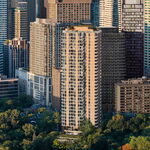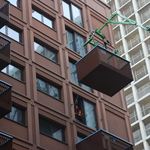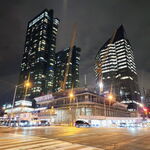RyanM12
New Member
30 year plan for Toronto.
Downtown.
There's no way the King line can be built North of Bloor. Too close in proximity to justify. If anything the East side could use the OL tunnel to branch.
30 year plan for Toronto.
Downtown.

I don't understand this comment. I assume you are referring to the East leg.There's no way the King line can be built North of Bloor. Too close in proximity to justify. If anything the East side could use the OL tunnel to branch.

This is a really big thing I just did, and I'm so stoked that I finally can share it. This is a culmination of all sorts of ideas I've had of how to improve Toronto's public transit system. I'm not super happy about the formatting, but considering what I had, I think it gets the point across without having too many colours.
I originally planned to have an Albion-Wilson-Bathurst line and a Dufferin-Wilson-York Mills line, but I think this arrangement works better because few people would be travelling from end to end anyways, and it would be more convenient for riders if the lines travelled in a relatively consistent direction. I'm not thrilled about the Classic LRT line arrangement south of Bloor/east of Parkside, but my focus was more on unlocking development potential in the yellow belt for this map.
(Edited to re-upload a new version, because the old one had a misplaced label.)
This isn't a shot directly at your plan but just a general thought, because I've seen this with the Metrolinx "future" plan as well. Why do most plans that have the OL or some equivalent going beyond Keel/Dundas West always miss Mount Dennis Station? Considering it will have bus access, GO Train access, UP access and Eglinton Crosstown access I find it odd everyone seems to miss sending the Subway to Mount Dennis and setting up as a west-end hub similar to Kennedy in Scarborough. It just seems like a no brainier to me and is something I've always had in my own long-term fantasy maps. As well turning Mount Dennis into a multi-model commuter hub can also be used as a launching point for the long since abandoned "York Centre" plan. I just find it strange we have this obvious choice right in front of us yet seem to somehow miss it. In my opinion not sending the OL or something like it to Mount Dennis would be a decision that would blow the minds of urban planers and transit planers the world over in its stupidity. I mean it's right there! How do you miss it?
There's little dispute on the route, so I didn't show it here, but eventually the Ontario Line is extended north to Seneca College.
I mean like this, it would poor planning to build a separate guideway 100m apart, and they couldn't justify it being built, especially when it's not serving any stops. This part could easily be interlined.
I could easily move either line to pass through Mount Dennis, but I am not sure it is such a busy node. Currently it has ZERO rapid transit. It will soon have 2 (GO/UP and ECLRT). I always thought Mount Dennis had limited development opportunity with Eglinton Flats on one side and Black Creek on the other.This isn't a shot directly at your plan but just a general thought, because I've seen this with the Metrolinx "future" plan as well. Why do most plans that have the OL or some equivalent going beyond Keel/Dundas West always miss Mount Dennis Station? Considering it will have bus access, GO Train access, UP access and Eglinton Crosstown access I find it odd everyone seems to miss sending the Subway to Mount Dennis and setting up as a west-end hub similar to Kennedy in Scarborough. It just seems like a no brainier to me and is something I've always had in my own long-term fantasy maps. As well turning Mount Dennis into a multi-model commuter hub can also be used as a launching point for the long since abandoned "York Centre" plan. I just find it strange we have this obvious choice right in front of us yet seem to somehow miss it. In my opinion not sending the OL or something like it to Mount Dennis would be a decision that would blow the minds of urban planers and transit planers the world over in its stupidity. I mean it's right there! How do you miss it?
Not sure if we are talking interim or final.I mean like this, it would poor planning to build a separate guideway 100m apart, and they couldn't justify it being built, especially when it's not serving any stops. This part could easily be interlined.
They are close for a very short stretch - mostly because that is a convenient lcoation for both lines to shift towards the northwest.I don't see both lines being built so close to each other... if anything maybe keep the King line on Dufferin.
Thanks.I like a lot of other ideas in the map though.
I'm still more of a fan of sending the OL (in your scenario) to South Etobicoke. If the name of the game is supporting development potential, The Queensway corridor and Sherway Gardens is very attractive. Having both lines extend north of Bloor seems like a duplication of service.For Western Toronto.
1. The Ontario and King Lines cross again in the west (at Bathurst). I'm not convinced going to Exhibition is the best strategy - but it's not a terrible idea, and it provides an opportunity for an interchange station in the West. The King Line has stations on the Kitchener GO line, while the Ontario Line meets the LSE GO and Kitchener (@ Dundas West). The King Line is fully buried, while the Ontario Line may be elevated through Exhibition.

2. Crossing Bloor, the two line fan out a bit. The King Line gets to Keele, following roughly Davenport to make the job west. The Ontario Line follows Dundas to Scarlett Road.
Not shown, but the King Line likely stops at Lawrence - possibly someday meeting the Sheppard Line at Sheppard/Keele. This whole thing would have to be buried.
The Ontario Line could switch from buried to being elevated at Scarlett/St. Clair and go up Scarlett, then Weston Road, and eventually Albion.

I worry the Queensway route is too close to Bloor.I'm still more of a fan of sending the OL (in your scenario) to South Etobicoke. If the name of the game is supporting development potential, The Queensway corridor and Sherway Gardens is very attractive. Having both lines extend north of Bloor seems like a duplication of service.
Running elevated along the Gardiner works if the purpose was to intercept feeder routes. I don't think that is so important in this part of the city, and would be detrimental to fostering development along The Queensway. I would favour underground along The Queensway, I can't imagine it being as complicated or expensive of a tunnel as in Downtown Toronto. Elevated could work too.I worry the Queensway route is too close to Bloor.
Could this run elevated along Queensway?
Would an elevated route beside the Gardiner (similar to Montreal REM) work?
Would elevated along Lakeshore be acceptable?
Is hitting Mimico or Humber shores important?




